Do you want to join the ranks of Bigby, Melf, Mordenkainen, and Rary? Then it’s time for you to craft some spells! Spells are one of my favorite elements of fifth edition Dungeons & Dragons to create because magic is limited only by our imaginations. That said, spells have a lot of moving parts that help the incantations find their places in the game. Getting a spell’s level right is the real trick to balancing it all, but in that question there are several other considerations like the spell’s range, casting time, and potential concentration requirement.
Have no fear. This article provides step-by-step instructions for making a balanced spell in D&D.
Before You Start, Ask the Important Questions
Before you begin to design any new element of the game, don’t forget to ask these three questions, the importance of which are discussed in the first Design Workshop article:
- What do I want to make?
- Does my creation already exist as official D&D content?
- Can I reskin or tweak another creation to suit my needs?
If the spell you’re considering designing doesn’t already exist and can’t be built by tweaking an existing one, it’s time to design your own.
Designing Spells
The Dungeon Master’s Guide provides guidelines for creating a new spell, which are great. I’ll expand on these guidelines to give a more in-depth look. All spells have the following pieces you need to design:
- Spell level
- School of magic
- Casting time
- Components
- Spell range
- Duration
- Description
- Ritual
- Higher level scaling (optional)
- Classes
Building your spell in D&D Beyond makes life easy. The application breaks down a spell’s elements in an easy-to-use form. Select SPELLS > CREATE from the D&D Beyond homepage and then click CREATE FROM SCRATCH to get started.
For this article, I created two new spells called shorten/stretch limbs and thunder shout.
Step 1. Spell Level
Once you have an idea for your spell, it’s best to pick the spell’s level so you have other spells as guidelines to work against rather than designing the other elements of your spell and then trying to assign it a level later. You can adjust the spell’s level as you design. Think about other spells your spell to which yours is similar to get a target spell level going.
Shorten/stretch limbs is a spell like enlarge/reduce that only affects a target’s limbs. Reduce/enlarge is a 2nd-level spell, so I’ll do the same for shorten/stretch limbs. Thunder shout has an area of effect and deals damage similar to the 3rd-level fireball spell, so I’ll make thunder shout 3rd level.
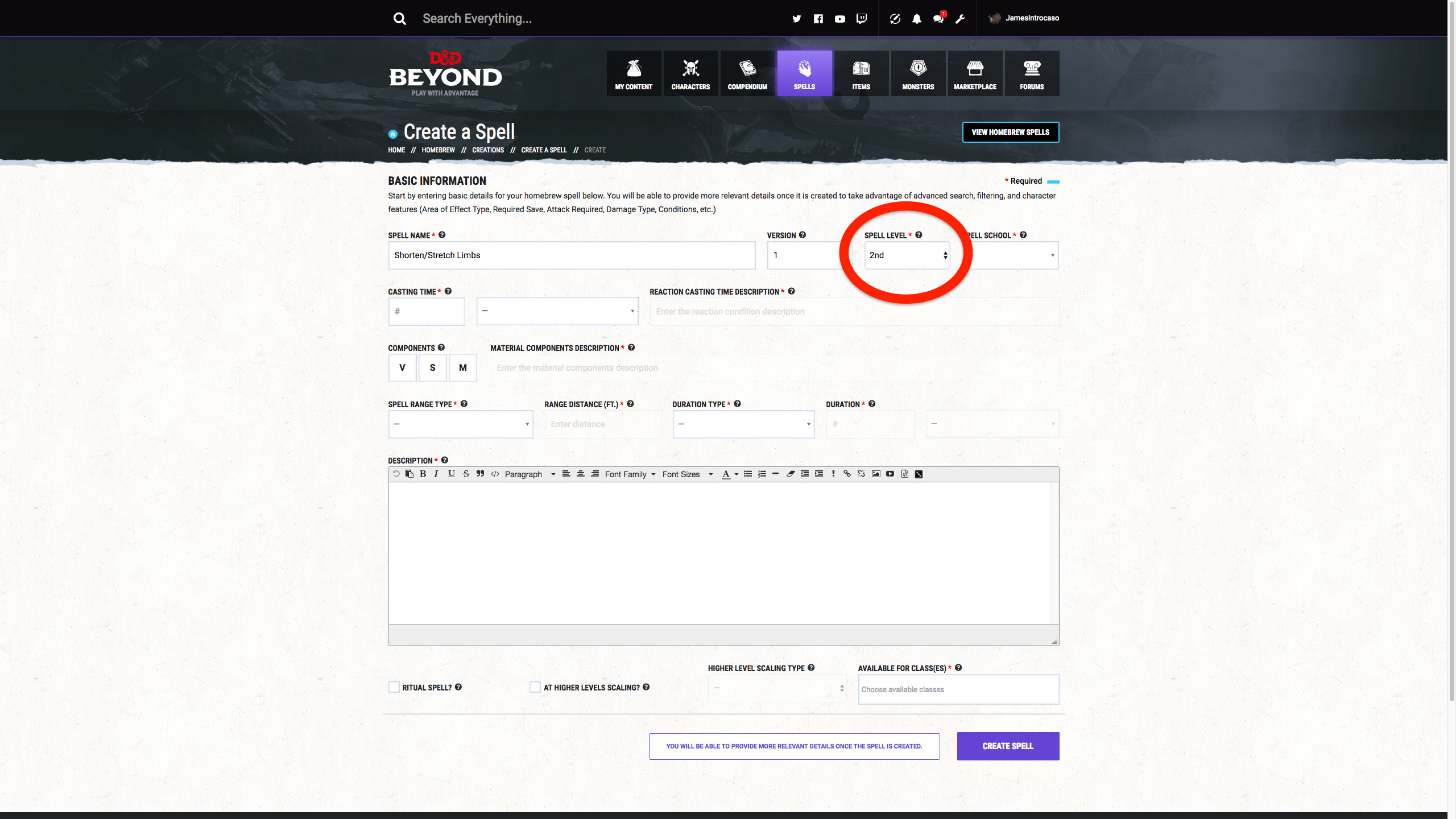
Step 2. School of Magic
What school of magic fits your idea for the spell? If you’re unsure, look at similar spells and read the description of the different schools of magic.
Based on similar spells, shorten/stretch limbs is a transmutation spell, and thunder shout is an evocation spell.
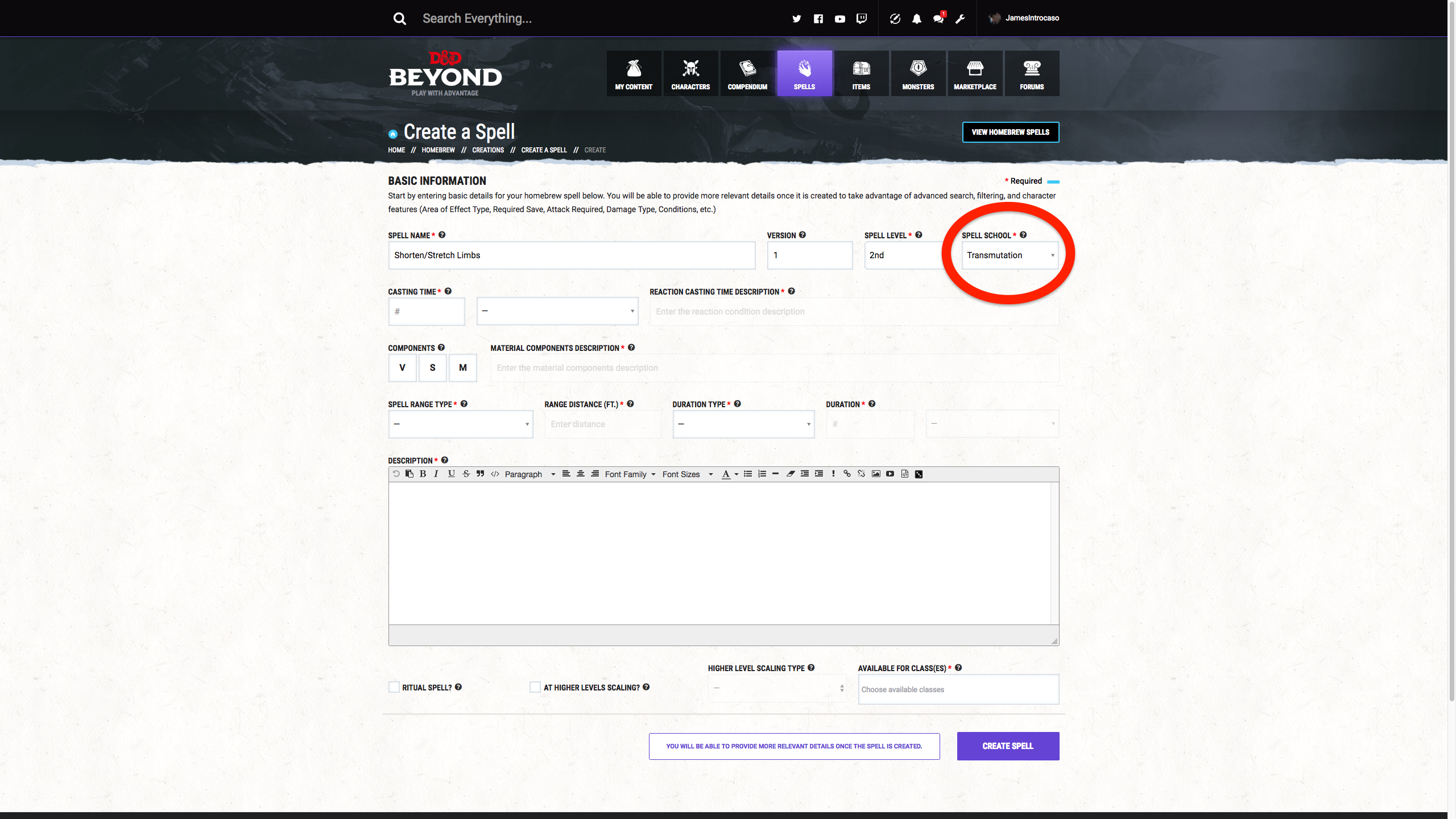
Step 3. Casting Time
Official spells have one of the following casting times: 1 action, 1 bonus action, 1 reaction, 1 minute, 10 minutes, 1 hour, 8 hours, 12 hours, or 24 hours. By far the most common of these is 1 action, so consider that the standard for spells.
If your spell is cast as a reaction or bonus action, its overall effect for its level should be less powerful. Compare the healing potential of healing word, which takes a bonus action to cast, to cure wounds, which takes an action. Both are level 1 spells, but healing word only restores 1d4 plus a spellcasting modifier’s worth of hit points while cure wounds heals 1d8 plus the caster’s spellcasting modifier.
If your spell takes 1 minute or longer to cast, you can increase its overall power for its level. Prayer of healing, a 2nd-level spell, heals five more creatures than a casting of cure wounds using a 2nd-level spell slot, but it also has a casting time of 10 minutes. Keep in mind that if you spell takes more than 1 action to cast, odds are no one will cast it during combat.
Shorten/stretch limbs and thunder shout both have a casting time of 1 action, since they are both meant to happen during combat.
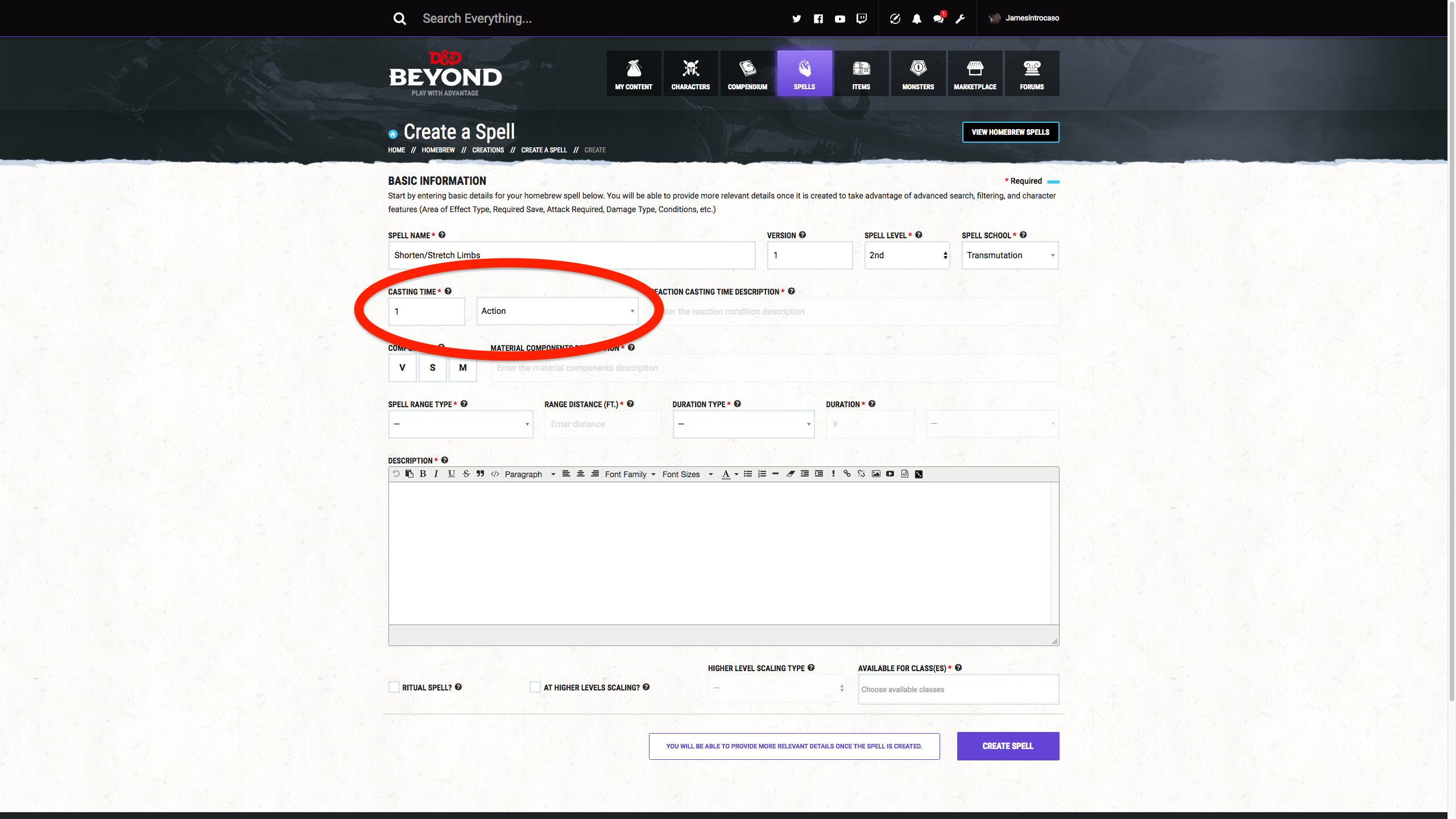
Step 4. Components
Components are a bigger part of balancing a spell than many people think. All official spells have at least a verbal or somatic component. (There are no spells the require just material components and no spells that require no components.) Most spells have verbal, somatic, and material components, though the material component usually has no cost. Use that array of components as the standard. If your spell has fewer components, then it’s easier to cast which affects its balance, but not drastically. If your spell has a costly material component, then its effect should be more powerful than the average spell of its level.
Before you decide which components your spell has, review what each means mechanically so you know why the spell is easier to cast without one of the components. Compare healing word and cure wounds again. The former has only a verbal component and is weaker and the latter has both a verbal and somatic component and is stronger. The action economy is the heavier determining factor here, but it should be pointed out that a cleric can’t cast cure wounds while bound and can still cast healing word.
There are two kinds of costly material components, re-usable focuses, such as that required by the scrying spell, and consumed components, like the diamond used with the raise dead spell. Since both raise dead and scrying are 5th-level spells, compare them to another that has no costly material components, destructive wave. Dealing 10d6 damage to and knocking prone each creature within 30 feet the caster chooses with destructive wave is nothing to sneeze at. But compare that magic to the ability to spy on anyone anywhere in the same plane of existence as you and it doesn’t feel as powerful. Then compare both those spells to the ability to bring a dead person back to life and both pale in comparison. The material components help balance the casting of these spells out.
When you’re creating material components that don’t cost any money, have some fun! There’s lots of good jokes in the official spells.
Shorten/stretch limbs and thunder shout both require verbal, somatic, and material components (but no costly material components).
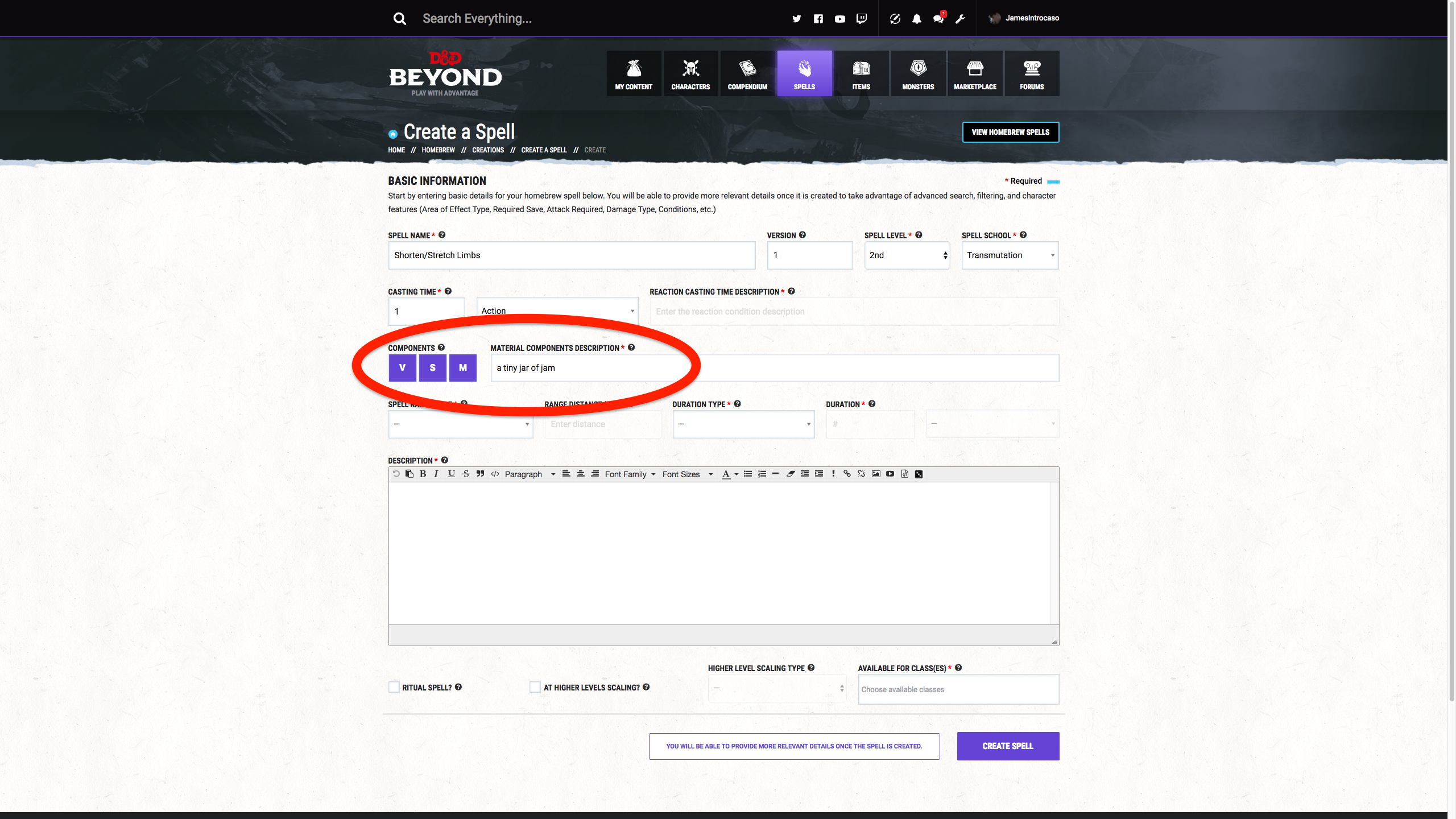
Step 5. Spell Range
A spell’s range also matters more than you might think. As James Haeck points out in his D&D Beyond article about the fireball spell, range helps make this spell awesome (and also helps casters not blow themselves up). Consider the following questions when determining the range of your spell:
- Does your spell create an area effect? If so, would most people casting the spell want to be included in its effect?
- What is the range on some similar official spells or the same level? Let those spells guide your design.
- Does your spell create the effect another spell of the same level does, but at a different range (like healing word and cure wounds)? Then the effect of the spell the allows for greater range should be weaker than the effect of the spell with the shorter range.
Thunder shout is an area effect spell that originates with the caster, so that has a range of self. Shorten/stretch limbs has a range of 30 feet, which is the same as the similar spell of the same level, enlarge/reduce.
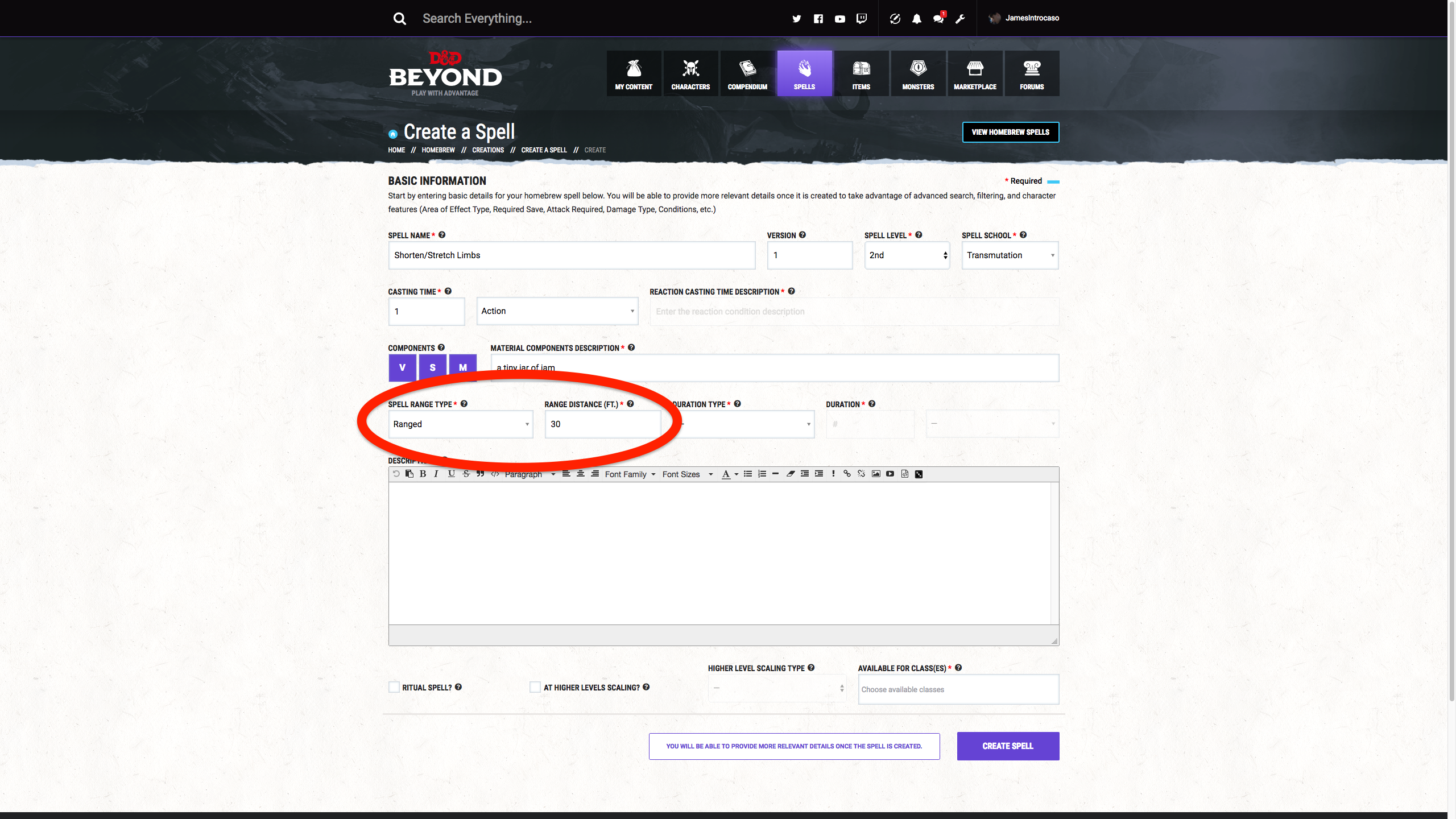
Step 6. Duration
When it comes to your spell’s duration, look at other spells of similar effect and the same level. Duration has a big impact on your spell’s balance. Imagine how much more powerful spells like banishment, greater invisibility, and hypnotic pattern would be if their duration were 1 hour instead of 1 minute? At the very least, a massive increase in the spell’s level would be called for to balance them.
Here’s a guideline: spells that shouldn’t last for longer than a single combat encounter should last 1 minute or less and spells that shouldn’t stay in effect if the characters stop to rest should last 1 hour or less.
Another aspect of duration to consider is concentration. Do the other spells you’re comparing your spell to also require concentration? Would your spell no longer be in effect if its caster is incapacitated? Does it seem unbalanced that a caster could cast this spell and also cast fly, invisibility, stoneskin, or another concentration spell? If you answered yes to any of these questions, then your spell likely requires concentration. Most spells that last more than a round require concentration. Those that do not have weaker effects than those that do.
Thunder shout happens and is over and therefore has a duration of instantaneous. Shorten/stretch limbs has a duration of 1 minute and requires concentration, like enlarge/reduce.
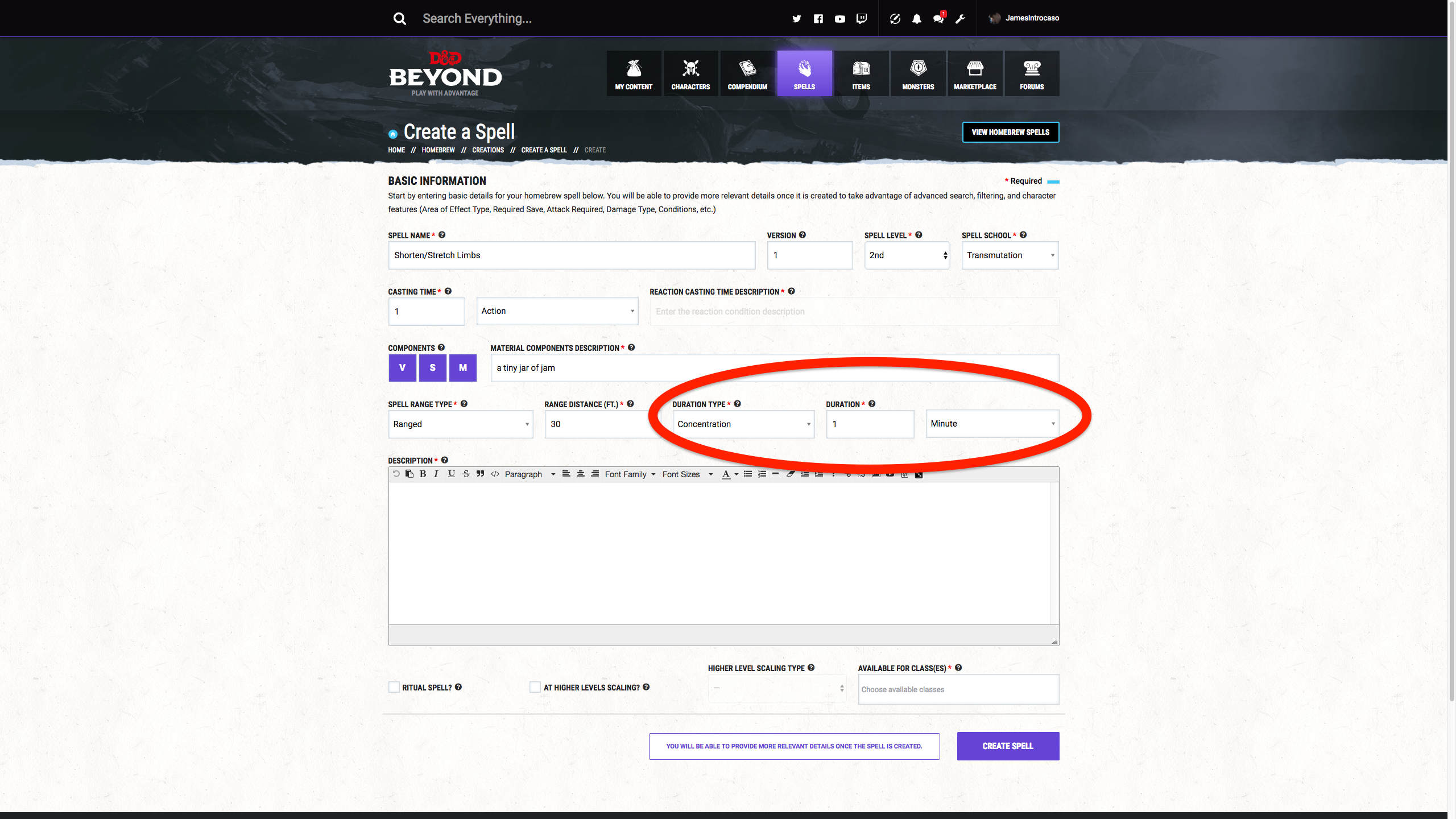
Step 7. Description
Your spell’s description should provide any flavorful and mechanical effects caused by the spell. This is where balance is most important, so review the spell creation guidelines in the Dungeon Master’s Guide and find similar spells to compare to yours. There’s limitless possibilities with magic. Each spell is its own little exception to the rules, so make sure you compare and contrast.
If your spell effect is unique and no other spell that comes close to what it makes happen, take your best guess as to how to balance it for its level and then playtest the heck out of it before making it public.
The Dungeon Master’s Guide gives great advice on balancing spells that deal damage, though it’s not always spot on (fireball and lightning bolt both do more damage than recommended and I’ll let James Haeck tell you why), but between that advice and looking at similar spells, you should be able to create a balanced damage effect. If your spell has an additional effect beyond damage, adjust its damage (or one of the spell’s other variables) to keep it balanced. Thunder shout is such a spell. I compared it to other 3rd-level damage dealers like fireball, lightning bolt, and melf’s minute meteors. Here is its description:
You shout a thunderous word of power that explodes outward from you. Each creature within 20 feet of you (not including you) must succeed on a Constitution saving throw or take 6d6 thunder damage and be pushed 10 feet away from you. A creature that succeeds on its saving throw takes half as much damage and isn’t pushed.
Spells with other effects can be more difficult to nail down. You should find as many similar spells as you can of the same level and other levels to help you balance it out.
If the spell inflicts a harmful non-damaging effect that a saving throw totally nullifies, make the effect big (and give the subject a chance to save against an ongoing effect at the end of a turn or upon taking damage). For instance, blindness/deafness, a 2nd-level spell, makes a target who fails a saving throw blinded for 1 minute and gives them a repeat save every round. That’s detrimental, but requires many failed saving throws, so few subjects spend the entire minute blinded if it affects them at all. That’s why it’s on the same level as a spell like darkvision.
I compared shorten/stretch limbs to enlarge/reduce, haste, longstrider, and slow. Here is it’s description:
You cause a creature with arms and/or legs that you can see within range to shorten or stretch its limbs for the duration. If the target is unwilling, it can make a Constitution saving throw. On a success, the spell has no effect.
Shorten. The target's walking speed decreases by 15 feet and it makes weapon attacks with disadvantage.
Stretch. The target's walking speed increases by 15 feet and its reach with melee weapon attacks doubles.
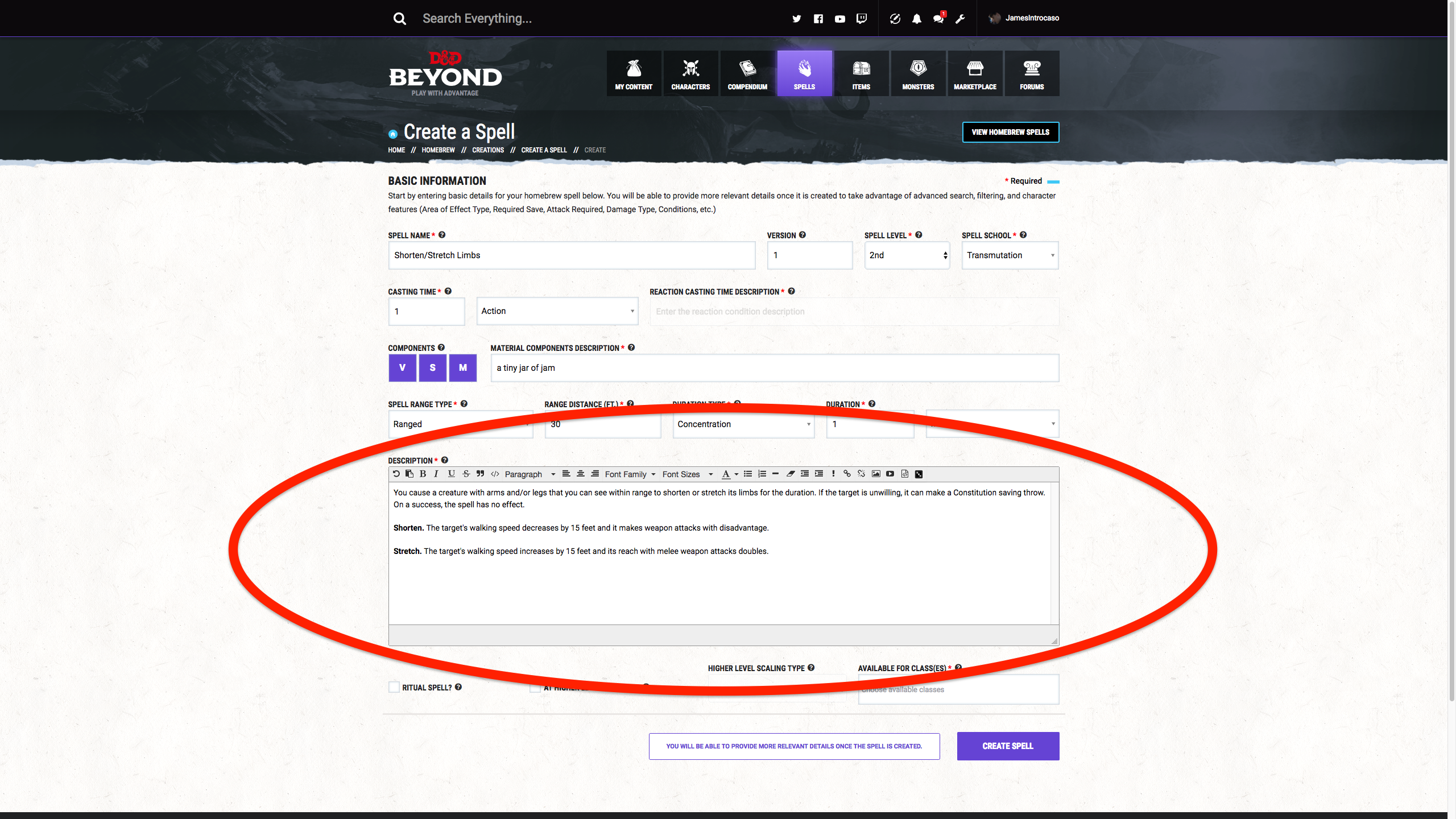
Step 8. Ritual
Of hundreds official fifth edition spells a mere thirty-three are ritual spells. Spells that can be cast as rituals are utility spells that are not usually cast during combat. They have one other guideline, which is that they’re the kind of spell that can be cast to help the characters move the story forward.
Imagine you’re running an adventure and your players need a key in an underwater cave to advance the plot. None of the characters can survive without air for that long and the druid who prepared water breathing is out of spell slots. Good thing the druid can cast the spell as a ritual and the story can move forward without forty-five minutes of your players arguing about how long air would last in an upside-down bucket and how long medieval wood could withstand the pressure at 20 feet down. Other ritual spells follow this guideline, like Leomund’s tiny hut and phantom steed.
Even if your spell isn’t meant to be cast in combat and can help advance the plot, think long and hard before giving it the ritual tag, especially if your spell has no costly material components since that means the spell can be cast an unlimited number of times. Think about how your players might use the spell in their downtime with unlimited castings. Leomund’s tiny hut just means the character has a magic shelter to live in, but unlimited castings of major image(a non-ritual spell of the same level) means the character can run the world’s longest con.
Neither shorten/stretch limbs nor thunder shout are ritual spells. I’ll leave the ritual box unchecked in D&D Beyond.
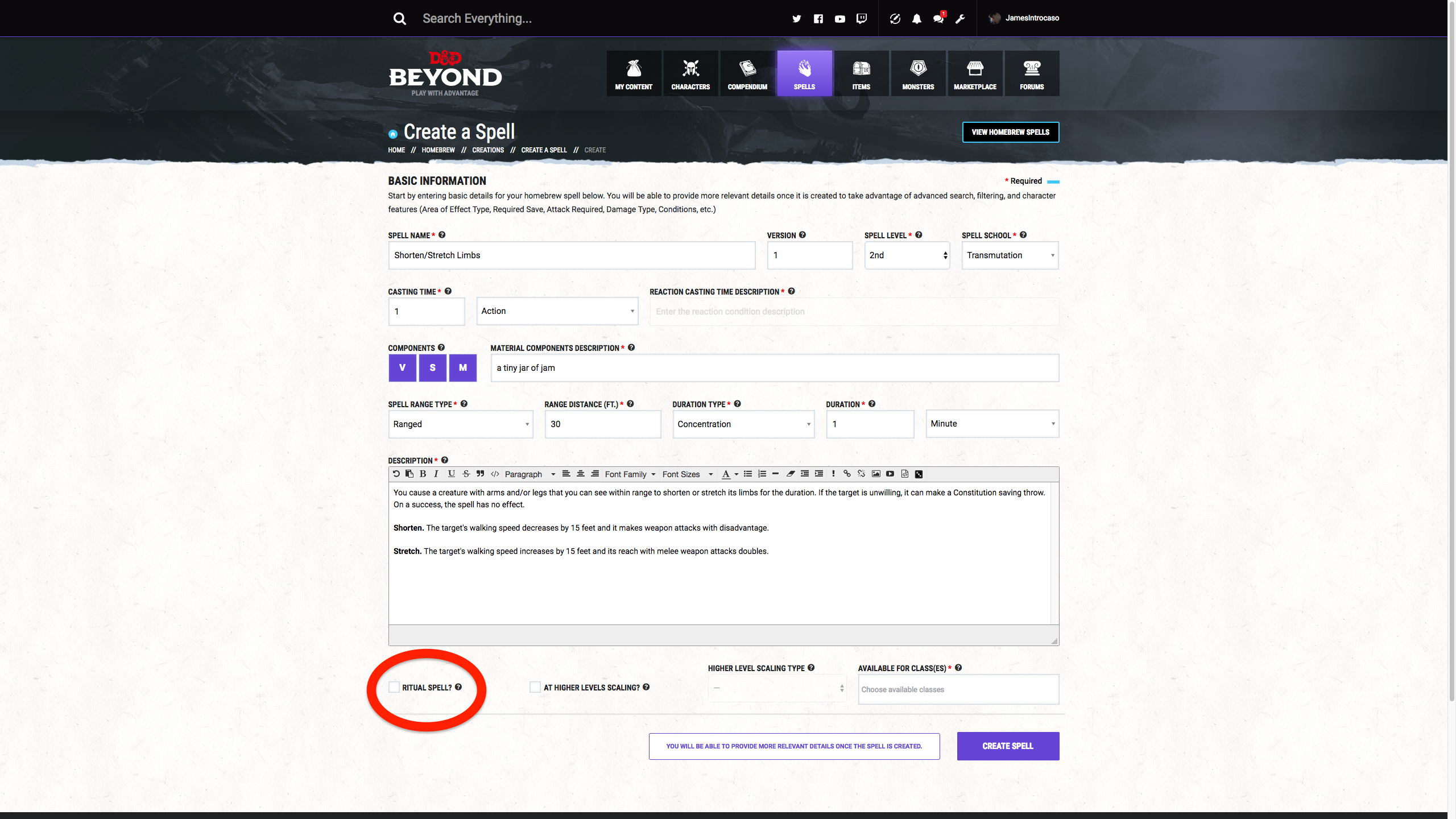
Step 9. Higher Levels
Your spell doesn’t need to have a greater effect if cast using a higher level spell slot, but many spells do. If you decide to do this, know that it should not affect the balance of your spell at the lowest level it can be cast, but it could affect the balance of your spell being cast at higher levels.
If your spell deals damage, then giving it another die of damage for each level beyond at the first which it can be cast is a great option as seen in fireball, lightning bolt, and phantasmal killer. That’s what I did with thunder shout.
If your spell has an effect beyond damage, once again look at similar spells. Blindness/deafness, conjure animals, and sleep all have higher level effects, but work in different ways. Many spells also have no effect at higher levels, like shorten/stretch limbs.
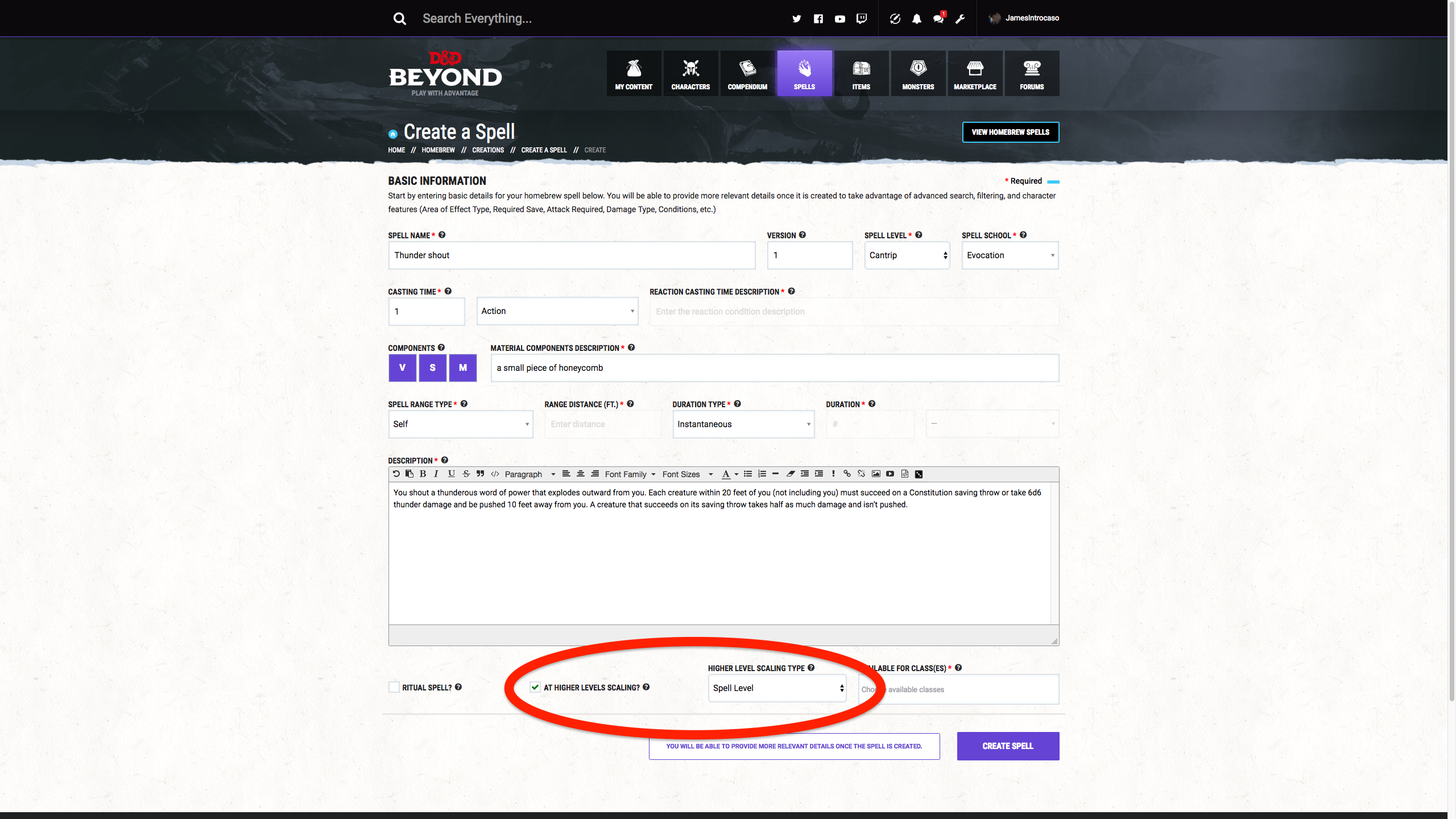
Step 10. Classes
What spells get access to your class? I have no better advice for this than what’s provided in the Dungeon Master’s Guide:
“Make sure the spell fits with the identity of the class. Wizards and sorcerers don’t typically have access to healing spells, for example, and adding a healing spell to the wizard class list would step on the cleric’s turf.”
Thunder shout is almost a souped-up version of thunderwave. I’m going to make that one available to bards, druids, sorcerers, and wizards like thunderwave. Since shorten/stretch limbs is similar to enlarge/reduce, I’m going to my spell to sorcerers and wizards to match.
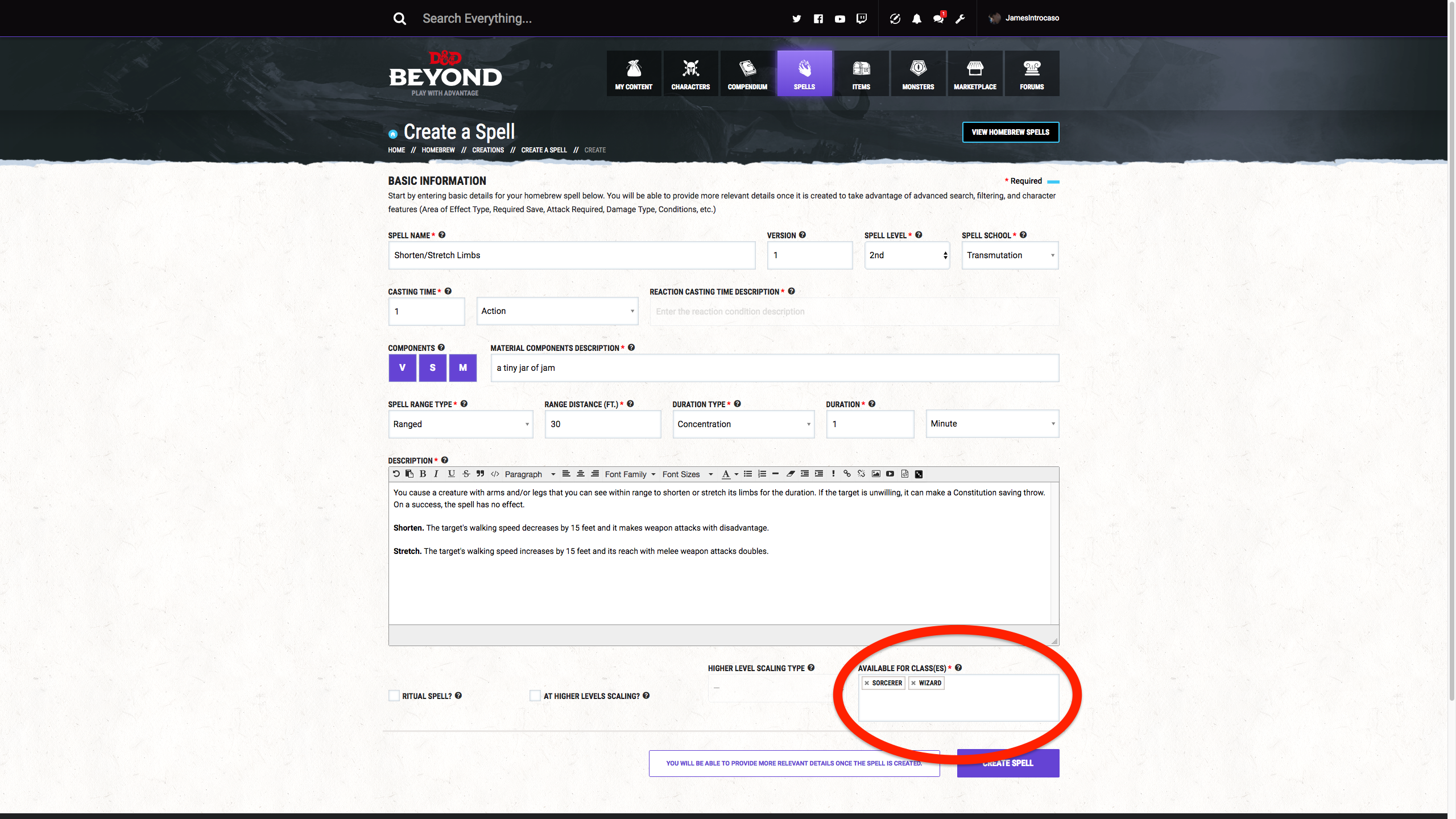
Step 11. D&D Beyond Elements
If you’re creating your spell in D&D Beyond, click CREATE SPELL to add the following:
- Add tags to make it easier for people to search for your spell. Shorten/stretch limbs got the buff and debuff tags. Thunder shout got the control and damage tags.
- Input information about your spell’s area of effect, type of attack, require saving throw, hit and miss effects. You don’t need to get crazy here. Just provide the basics, as seen in the screenshots.
- Add any modifiers, conditions, and higher-level effects. This information helps your spell play nice with the rest of D&D Beyond.
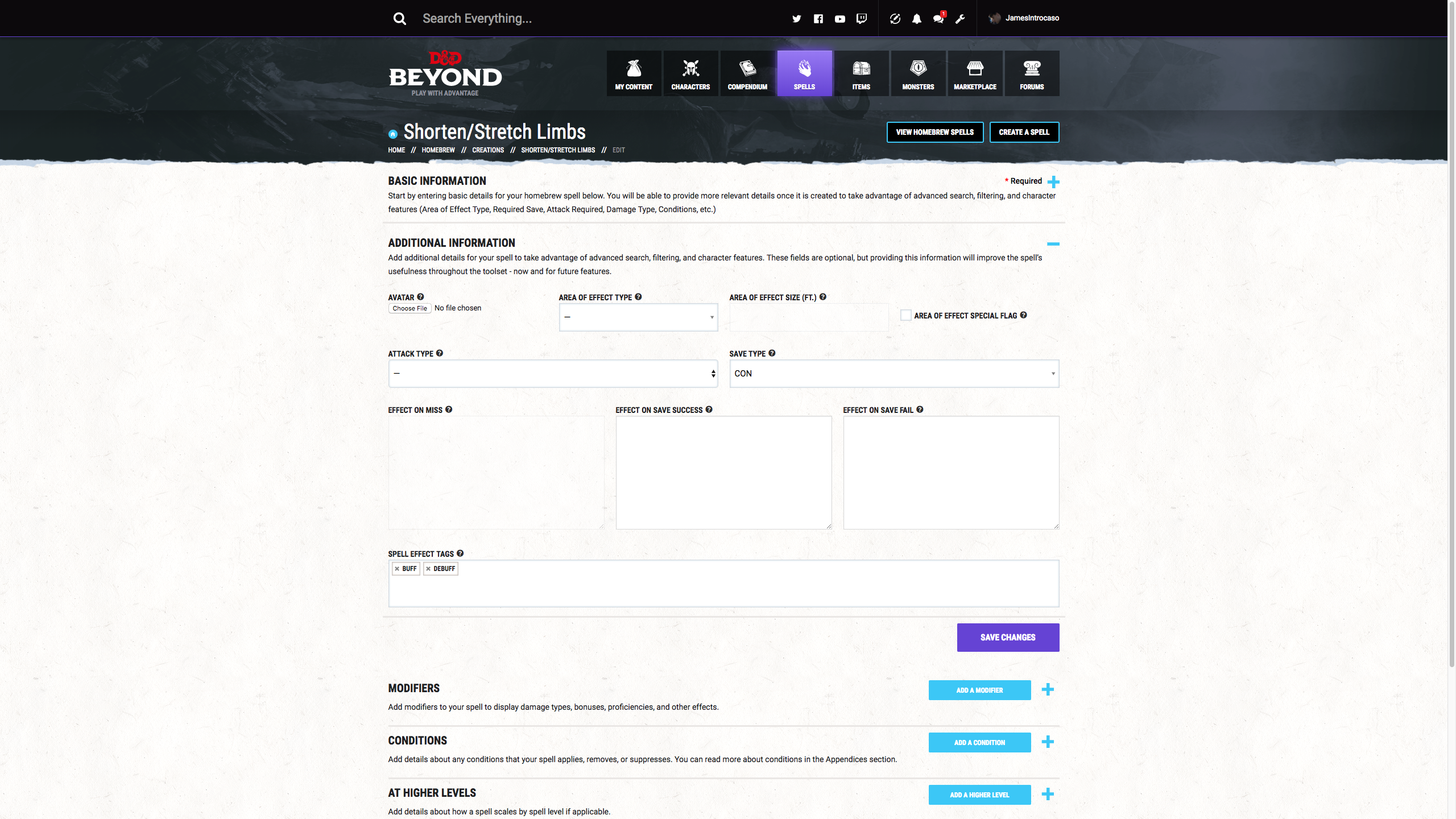
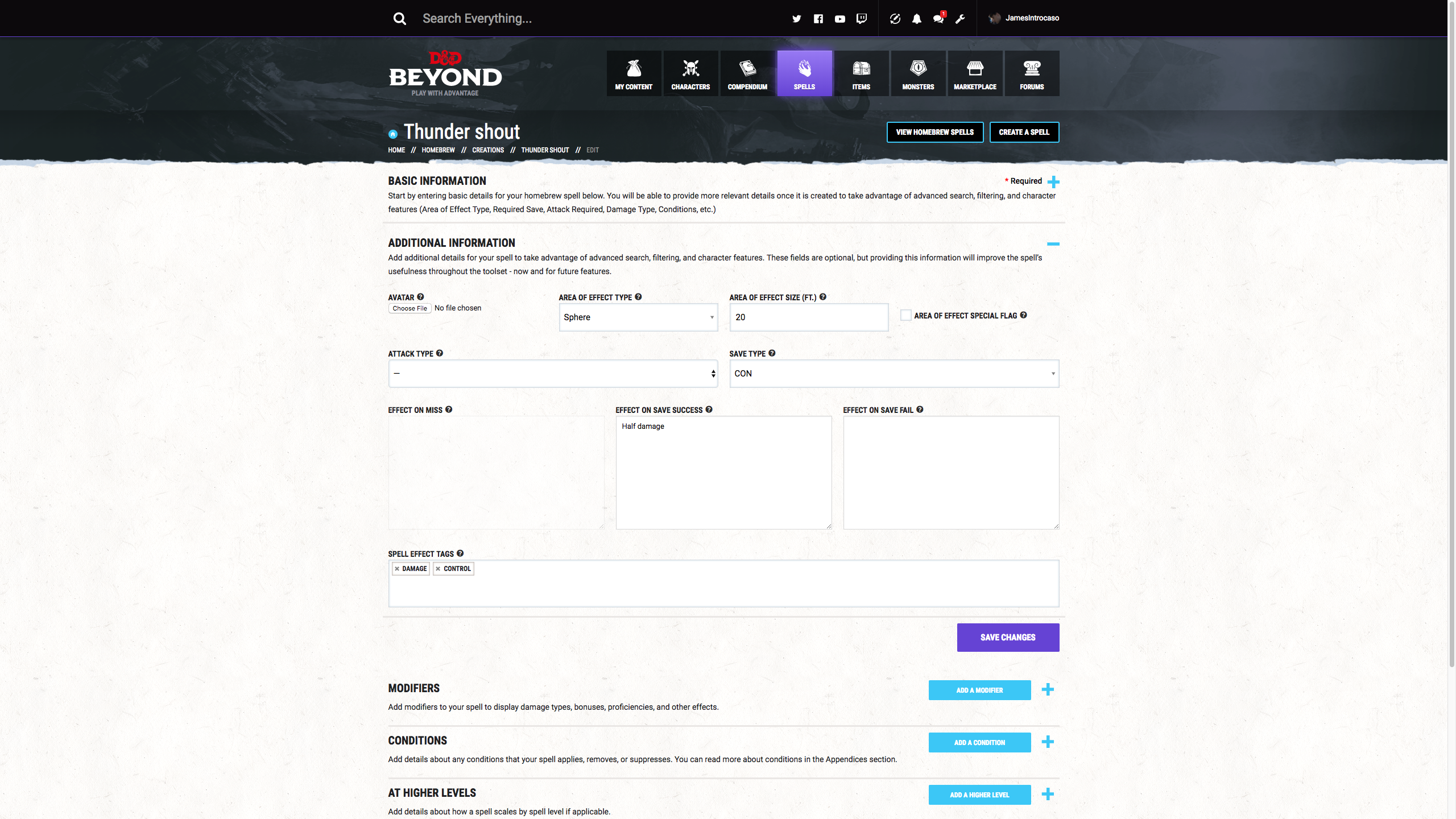
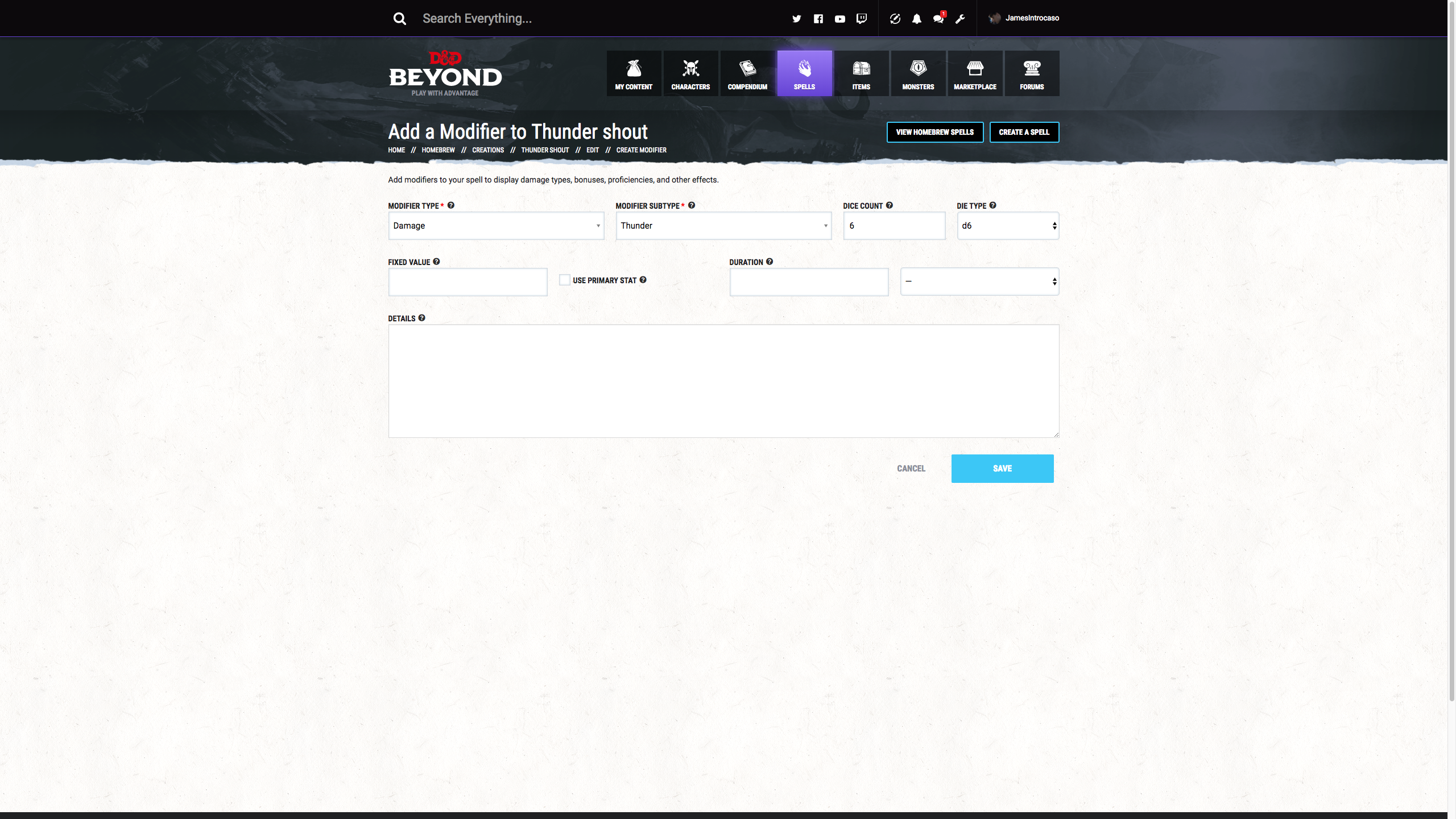
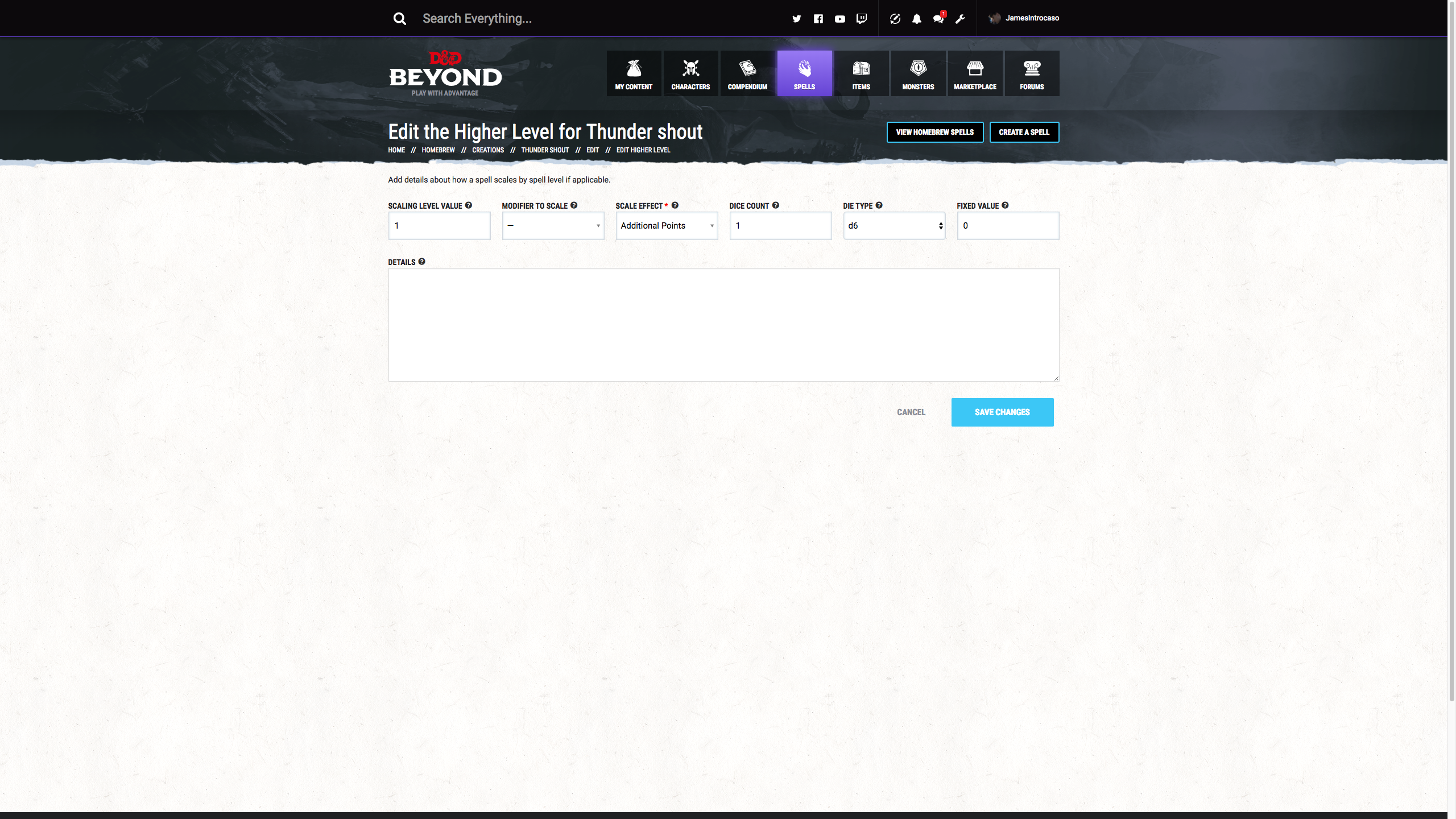
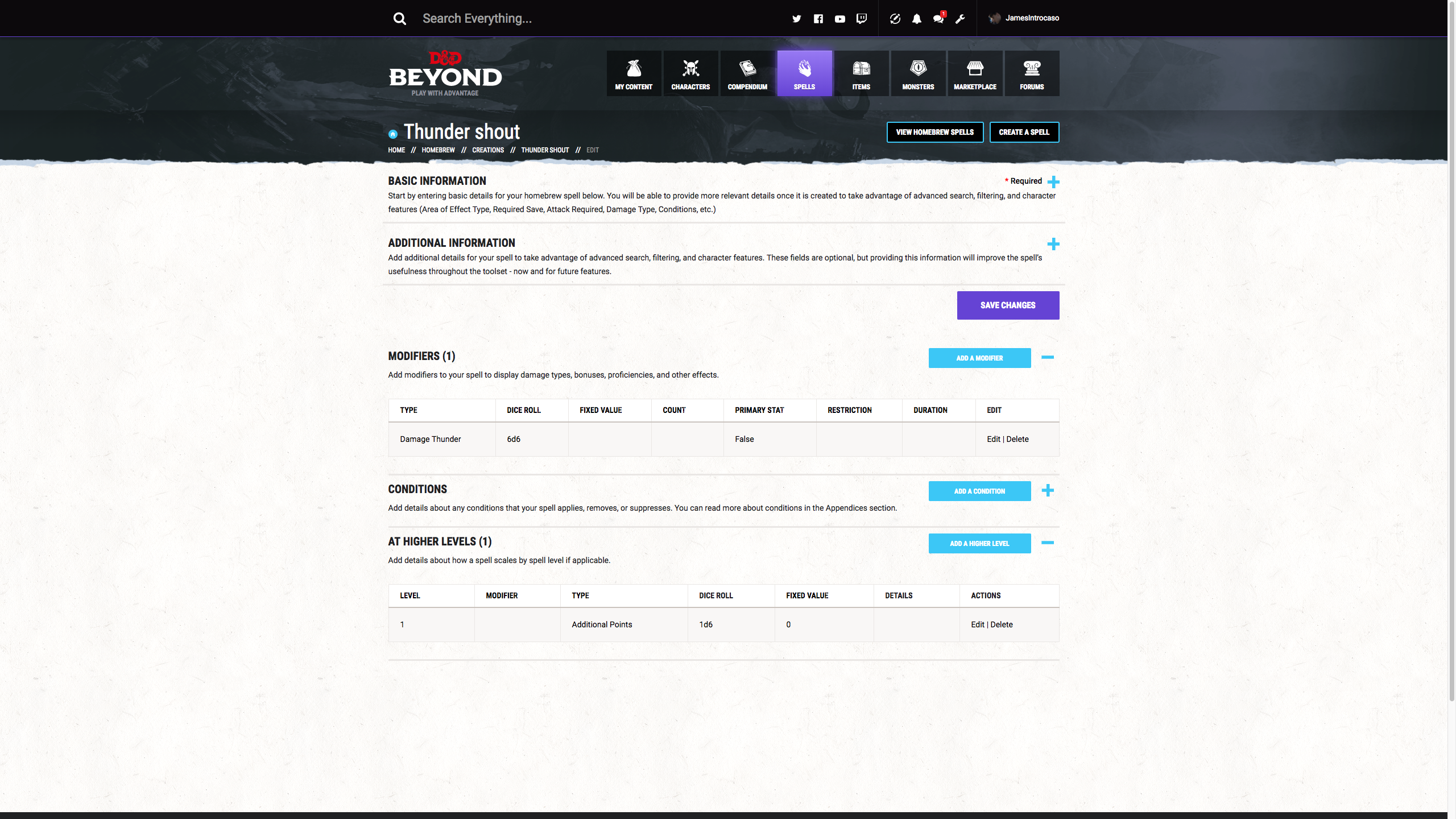
Step 12. Edit and Playtest
Now that you’ve created your spell, read it outloud and edit. Even the most experienced designers need to edit their work. Then send your work to a friend to make comments. A second pair of eyes helps you understand if the design intent of your spell is coming through.
If you have the opportunity to playtest your new spell, take it! Nothing is a better test of your design work than actually seeing it in action. It’s a great excuse to get friends together for a game of D&D! Give your spell to someone else to use during the playtest, again to see if the design intent comes through. Change anything you think needs it after playtesting.
Step 13. Make Your Work Public
It’s time to make your work public! That means sharing the spell with your group, posting it to a blog, putting it up for sale on the DMs Guild, or right here on D&D Beyond. To do this in D&D Beyond go to the MY CREATIONS page, select your spell, and click MAKE PUBLIC. A message then appears asking if you’ve read the Public Homebrew Content Rules & Guidelines and explaining the moderation process for public content.
When you’re ready to submit your spell, click SUBMIT and you’ll get a moderation notice from the D&D Beyond team once your submission is accepted or rejected. Make sure you actually read the guidelines. Most rejections happen because the creator hasn't followed one of the very simple guidelines, or because they're attempting to publish work they don't own or didn't create themselves. Please note that it is completely fine to keep your creation private if you intend to only use it in your own game and do not wish to share it.
Lucky for me my spells were accepted. Here are the final versions of shorten/stretch limbs and thunder shout.
Go Make Stuff!
There you have it! A step-by-step process for creating a D&D spell. I can’t wait to see what people submit to the great D&D Beyond. If your design gets posted, please share a link with me on Twitter, at @JamesIntrocaso.
James Introcaso blogs at World Builder Blog, podcasts at Don’t Split the Podcast Network, and designs games for Wizards of the Coast, Roll20, Kobold Press, Roleplaying Tips, and more.








-
View User Profile
-
Send Message
Posted Apr 10, 2018As a heads up you made Thunder Shout a cantrip.
-
View User Profile
-
Send Message
Posted Apr 10, 2018Ah yes I linked to my error version. Thanks for the heads up. It's fixed!
-
View User Profile
-
Send Message
Posted Apr 10, 2018The timing of this post is perfect! I literally fell asleep last night thinking about spellcrafting.
-
View User Profile
-
Send Message
Posted Apr 27, 2018Great sutff, just one thing I'm thinking. Maybe add a note saying this spell can be heard X number of feet away like all the other thunder spells?
-
View User Profile
-
Send Message
Posted May 15, 2018YO, I've never played D&D officially, but its fun!
-
View User Profile
-
Send Message
Posted Jul 14, 2020So, I made a spell, basically a copy of burning hands but with lightning instead of fire. Because of the rarer damage type, I changed the damage dice fro 3d6 to 2d8. Is this actually necessary for balance? At Tier 1, will it even matter?
-
View User Profile
-
Send Message
Posted Jul 17, 2020I'd suggest changing it to : 'its reach with melee weapon attacks increases by 5 feet' otherwise, Bugbears with Glaives suddenly have a 30 foot reach (or 20 if your DM realizes the polearm doesn't stretch, but by the wording, doubles is doubles) Also consider what an NPC with the spell can do given its other capabilities. A Dragon with Shorten/Stretch Limbs can suddenly do its melee claw or tail attacks a LOT further out, for example. I'd hate to face a Frost Giant with Shorten/Stretch Limbs.
-
View User Profile
-
Send Message
Posted Jul 24, 2020I can't find a list of descriptions of the effect tags. Some are obvious, but others less so. That would be helpful.
-
View User Profile
-
Send Message
Posted Jul 28, 2020Hello sorry may have missed it but in your description or while making my spell I can’t seem to find where I can make it a saving throw instead of attack based? Some reason the spell I made keeps coming up with to hit instead of dc of the spell. Thanks